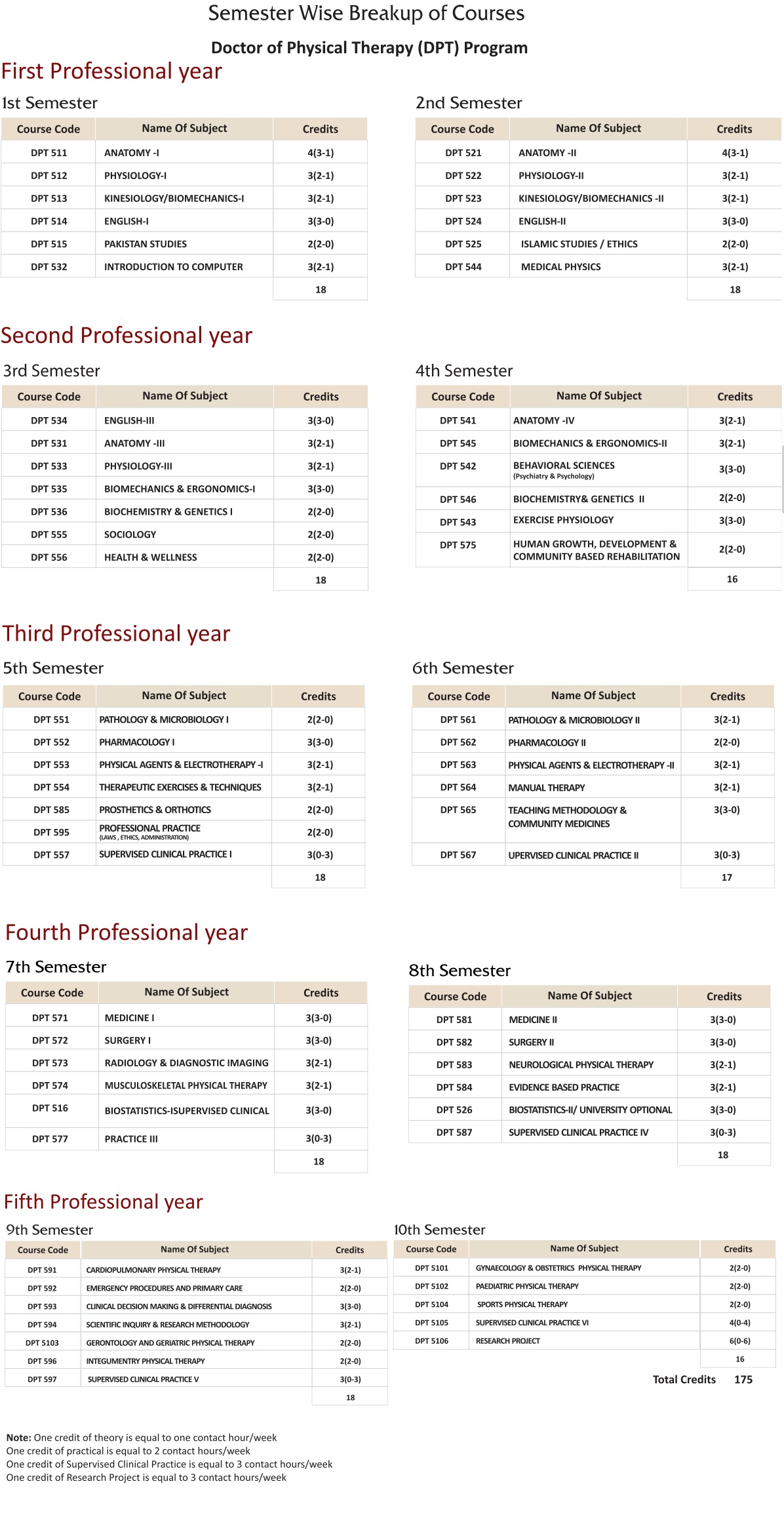The Doctor of Physical Therapy (DPT) program provides the required educational preparation for a professional career as a physical therapist. Program graduates are knowledgeable, self-assured, adaptable, reflective, and service-oriented practitioners who by virtue of critical thinking and ethical values make informed and independent judgments concerning patient/client needs, promote the health and quality of life of the client, and enhance the professional foundations for practice. These practitioners contribute to society and the profession through practice, teaching, administration, and the discovery and application of new knowledge about physical therapy. The educational philosophy of the program is to maximally challenge each student and facilitate his or her development of skills for life-long learning, professional development, and leadership.
DPT, a five years degree program spreads over 10 semesters. During the initial two years of program, emphasis is placed on Basic Medical and Physical Therapy Sciences and during last three years of program, apart from clinical attachments at hospital, special courses related to Rehabilitation and Medical sciences are offered. The Department of Physical Therapy & Rehabilitation is equipped with state of the art Basic Medical and Physical Therapy Sciences Laboratories, Digital computer Laboratory, Library and well-furnished class rooms.
We aim to produce competent Physical Therapy Doctors to fulfill the growing demands at national and international level. Education and training in global environment involves intense interaction between students and teachers with students being focal attention. Due to technological advancement and psychological discoveries the process of learning has undergone a radical change. Services of highly qualified and eminent Faculty have been acquired in the same context to provide students effective training.
Role of Physical Therapy Doctors in Health Care System
Physical Therapy doctors are experts in restoring and improving movement in people’s lives. They treat people throughout their lifespan — from newborn babies in the ICU to middle-aged people with athletic injuries to older people who are dealing with mobility problems that come with aging. They use scientifically based treatment techniques that focus on restoring function, reducing pain, and preventing disability. In many cases, Physical Therapy doctors help people avoid surgery or the need for long-term use of prescription medication. Their understanding of anatomy, biomechanics, exercise science, and movement analysis results in care that is unique to each individual as there is no “one size fits all” approach in Physical Therapy.
A wide variety of conditions are treated by physical therapy doctors, these are;
- Orthopedic conditions, including low back pain and osteoporosis
- Joint and soft-tissue injuries such as extremity injuries, fractures, dislocations, Tendonitis, and back strains
- Sports injuries stemming from overuse and trauma
- Neurologic conditions such as stroke and Parkinson disease
- Arthritic conditions including osteoarthritis and rheumatoid arthritis
- Systemic conditions such as cancer and AIDS
- Cardiovascular and pulmonary conditions such as heart diseases, breathing disorders,
- and peripheral vascular diseases
- Workplace injuries such as carpal tunnel syndrome
- Integumentary conditions such as burns, ulcers, and wounds
- Pediatric conditions such as developmental delay, cerebral palsy, and spina bifida.
Types of treatment protocols used by Physical Therapists
- Therapeutic exercise (includes aerobic conditioning)
- Functional training in self-care and home management (includes activities of daily living)
- Functional training in community and work (job/school/play) integration
- Manual therapy techniques (includes Mobilization and Manipulation)
- Prescription, application, and fabrication of devices and equipment’s (includes assistive, orthotic, protective, supportive, and prosthetic equipment’s)
- Other interventions include airway clearance techniques, skin protection and repair, Electrotherapeutic modalities, Physical agents and mechanical modalities.
Program Learning Outcomes
I. Graduates will evaluate clinical cases related to physical therapy and relate that obtain information through history taking to various disease processes.
II. Evaluate a deformity, set proper treatment goals, and establish prognosis according to established criteria.
III. Establish basic quality control procedures, confidence limits, and to follow standard guidelines of clinical routine procedures.
IV. Assess the reliability of special tests for each individual according to specific conditions through correlation of data with common physiological movements.
V. In prescribed instances indicate the need for improvements in diagnostic information.
VI. Graduates will apply knowledge of entry-level skills to accurately perform testing in all areas of the physiotherapy.
VII. Graduates will apply knowledge of entry-level skills to accurately perform testing in all areas of the physiotherapy.
VIII. Apply systematized problem solving techniques to identify and correct procedural errors, identify instrument malfunctions and seek proper supervisory assistance, and verify the accuracy of special test results.
IX. Perform comparison studies on new or existing procedures and report results according to conventional scientific formats.
X. Provide clinical orientation and supervision for students and new or less skilled clinical personnel. Lecture or provide class demonstrations.
XI. Graduates will demonstrate the elements of professionalism to operate as respected members of the health care team.
XII. Graduates will employ interpersonal communication skills in relaying clinical diagnostic test information and when interacting with patients, physical therapy clinical personnel and other health care professionals.
XIII. Graduates will comply with clinical safety regulations and standards.
XIV. Maintain focus on the patient to provide quality clinical services.


